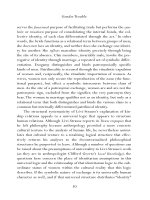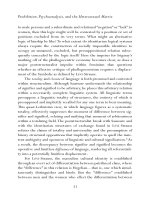GENDER TROUBLE 119
Bạn đang xem bản rút gọn của tài liệu. Xem và tải ngay bản đầy đủ của tài liệu tại đây (26.59 KB, 1 trang )
Gender Trouble
most pertinently, as a law of discourse, distinguishing the speakable
from the unspeakable (delimiting and constructing the domain of the
unspeakable), the legitimate from the illegitimate.
iv. Gender Complexity and the Limits
of Identification
The foregoing analyses of Lacan, Riviere, and Freud’s The Ego and the Id
offer competing versions of how gender identifications work—indeed,
of whether they can be said to “work” at all. Can gender complexity
and dissonance be accounted for by the multiplication and convergence of a variety of culturally dissonant identifications? Or is all identification constructed through the exclusion of a sexuality that puts
those identifications into question? In the first instance, multiple identifications can constitute a nonhierarchical configuration of shifting
and overlapping identifications that call into question the primacy of
any univocal gender attribution. In the Lacanian framework, identification is understood to be fixed within the binary disjunction of “having”
or “being” the Phallus, with the consequence that the excluded term of
the binary continually haunts and disrupts the coherent posturing of
any one. The excluded term is an excluded sexuality that contests the
self-grounding pretensions of the subject as well as its claims to know
the source and object of its desire.
For the most part, feminist critics concerned with the psychoanalytic problematic of identification have often focused on the question
of a maternal identification and sought to elaborate a feminist epistemological position from that maternal identification and/or a maternal discourse evolved from the point of view of that identification and
its difficulties. Although much of that work is extremely significant and
clearly influential, it has come to occupy a hegemonic position within
the emerging canon of feminist theory. Further, it tends to reinforce
precisely the binary, heterosexist framework that carves up genders
into masculine and feminine and forecloses an adequate description of
the kinds of subversive and parodic convergences that characterize gay
84









